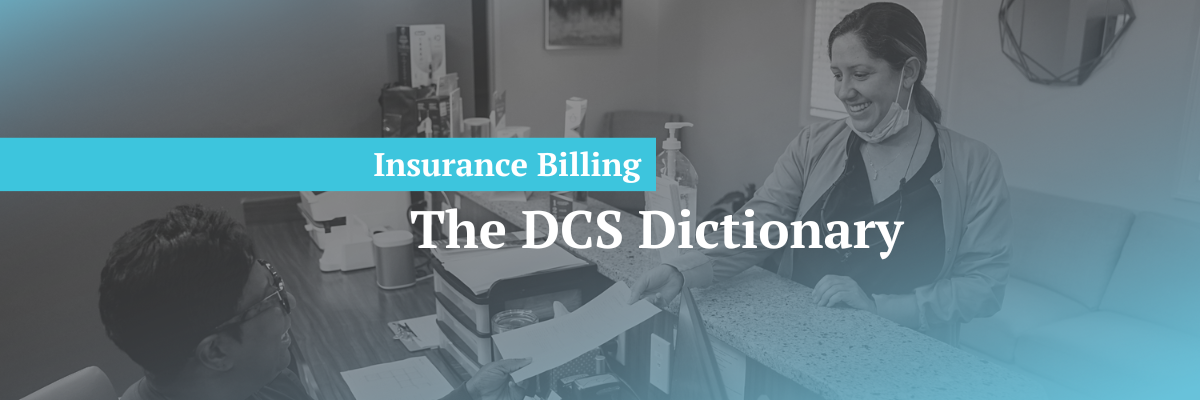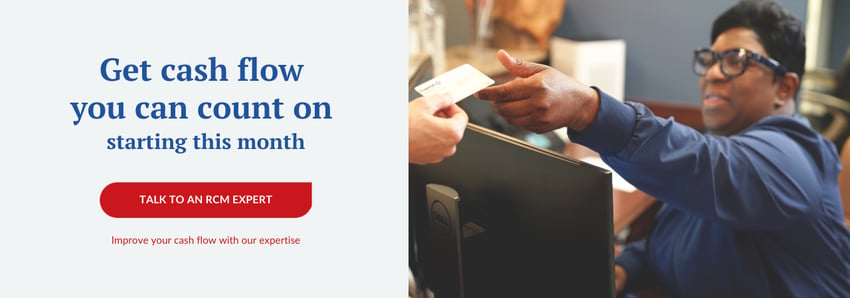Navigating the labyrinth of dental insurance billing can be as perplexing as reading a map with no legend. It's a world where ambiguous terms can lead to costly detours and missteps, causing dental teams to stumble through their billing process.
But fear not! This DCS Dictionary series is your compass for the bewildering world of dental billing terms.
Here at DCS, we are fluent in the language of insurance billing. As full-service revenue cycle management (RCM) providers, we work with dental businesses of all types, shapes, and sizes to ensure they have a smooth and efficient billing process.
Of our suite of services, dental insurance billing certainly has the highest demand. This is due to all the confusion that surrounds the dental insurance billing process, including the terms that are used.
We’re here to clear some of that confusion by defining 7 commonly misunderstood words in the dental insurance billing process.
1. Explanation of Benefits (EOBs)
An EOB is a document from a dental insurance company that details which treatments were covered, the coverage amount, and any remainder the patient owes.
An EOB typically includes the:
- Amount of deductible applied (or not)
- Allowed/considered fee
- Amount charged to service provider
- Procedure code(s) billed
- Amount paid by insurer
- Percentage of cost covered
EOBs may also help explain payments with remarks such as:
- Denied procedures, including details about how to appeal
- Additional information requested from the provider
- Additional information requested from the patient
- The insurance maximum has been met
DCS’ Operations Coordinator, Harry Levy explains—
“Think of EOBs as your go-to guide for understanding claims, breaking down payments, and keeping those expenses in check. It's all about making the insurance game a little more understandable.”
An EOB is a helpful tool for dental teams and RCM experts when it comes to record keeping and verifying information. It details exactly what your patient owes you, and if you haven’t collected that full amount from the patient yet, you can cite their EOB for the amount.
Related: How to prevent HIPAA violations with this new way to file EOBs
2. In-network vs out-of-network
When your dental practice is in-network with insurance companies, it means you have a contractual agreement with them. This makes your practice a “participating provider.” The contract you enter will define the patients who come into your practice, your claims' reimbursement process, and the rate of your fees.
When you’re an out-of-network dentist, you’re not in any kind of contractual agreement with insurance companies. You may still accept insurance, but you can charge your full fee to patients — and you can decide the type of care you give to patients without the input of the insurance company.
Whether you are in-network or out-of-network, you will follow a similar path through the revenue cycle, but there are differences. Knowing how the processes differ is key if your practice decides to switch from in-network to out-of-network, or vice versa.
Related: In-network or out-of-network: Pros and cons for your dental practice
3. In-network adjustment
An in-network adjustment is the difference between a dentist's full fee and their contracted fee.
For any particular service, the fee you charge before entering into a contract with an insurance company is likely different from the fee you will agree to charge within that contract. That price difference is your in-network adjustment, and it usually means charging less.
One reason many dental business owners prefer remaining out-of-network is because they can charge higher fees. If you choose to go in-network, knowing your in-network adjustment will be useful when negotiating your fee schedule with insurance companies.
Related: Write-offs, adjustments, and patient out-of-pocket: How your PPO impacts dental billing
4. Insurance AR vs patient AR
To put it as simply as possible, an insurance aging report (AR) lists money owed to the dental practice by insurance companies, while a patient account receivable (AR, also) is money owed to the practice by its patients.
Both are pillars of a practice's financial health and require diligent tracking and management — you must collect what you’re owed from both sources of revenue.
Make both your insurance AR and patient AR processes more efficient with:
- Digital billing, online payments, and automatic reminders for patient billing
- Expertise from an RCM provider like DCS for cleaner claims and quick appeals
Related: 3 reasons to automate your patient billing services ASAP
5. Clean claim
A clean claim is a dental insurance claim that is accurately completed with all the necessary information, so there are no delays in processing and payment.
Submitting a perfect claim is the only way to get paid ASAP. Insurance companies will use any excuse to deny a claim. Here are 4 things you’ll need for a clean claim:
- A current and correct claim form: medical or dental
- Complete and accurate dental patient information
- Complete and accurate codes and billing entity/provider information
- Appropriate attachments and clear documentation
This is not as easy it may sound because insurance companies regularly change forms, codes, policies, and guidelines, and those vary from one insurance company to another.
To guarantee prompt payments, it’s crucial that whoever is in charge of managing your revenue cycle stays up to date on changing requirements.
Keep reading: 4 things your dental insurance claim needs for reimbursement
6. Fee schedules
A fee schedule is a listing of fees used by insurance companies to pay doctors, dentists, and other providers or suppliers at the insurer-specified contracted in-network rates. These fees are the maximum amount a patient can be billed for a service, and the maximum amount the patient’s plan will pay for covered services.
The fee schedule should be updated and renegotiated every 1 or 2 years. We have met some dental businesses who haven’t updated their fee schedules in 3 or more years. If you haven’t taken the opportunity to increase your rates, that’s revenue you could be missing!
Payers make it a challenge to collect what they’ve promised, so they’ll certainly never pay more than is expected. Your claims should request your full fee so that if there has been a change to your fee schedule, you’ll be sure to collect every dollar. If your claims request less than the maximum available, your practice will lose out on revenue it could be collecting.
Related: 3 ways that old or missing fee schedules derail your dental practice
7. Credentialing versus enrollment
Credentialing and enrollment are terms often confused by dental teams who mistakenly think they are interchangeable.
Credentialing is the process where an insurance company approves a dental provider to join their insurance network.
Enrollment is the process where a dental provider registers with an insurance company to receive payment.
Related: Top 5 mistakes dentists make in the dental credentialing process
Some dental providers assume once they are credentialed, they are also enrolled with the insurance company — but these are two different steps. Credentialing is done first, typically, and once you’re accepted, then you can enroll.
When you partner with DCS to manage your credentialing process, we take care of both credentialing and enrollment, so your dental team can get to work and get paid. This bypasses confusion, as it’s all handled by our RCM experts.
Access the DCS Knowledge Network to ensure accuracy and maximize profits
These terms are not academic; they’re a financial necessity to your dental business. Not fully understanding these terms and the processes behind each could lead to costly mistakes in your insurance billing process.
And if reading through these terms made you feel overwhelmed: Don’t worry. The DCS Knowledge Network is here to help.
When you work with DCS, you have access to our Knowledge Network: A pool of over 100 experts who specialize in dental revenue cycle management, including insurance billing.
Knowing you have experts you can turn to when things get confusing in your insurance billing process will bring peace of mind to your stressed-out dental team.
Access the DCS Knowledge Network and never worry if your team is making costly mistakes: Schedule a free consultation with us.
Related Posts
Dental revenue resources from Dental Claim Support



